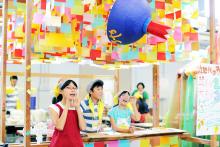What's On Featured
Search Events
Latest News
Do you know what Kaunas and San Francisco have in common? Trolleybuses! Street art, too. The electric public transport has been circling around the city of Kaunas for more than 60 years now. Recently Kaunas Municipality signed a deal with a Polish company that will deliver, in collaboration with street artists, 85 brand new looks to trolleybuses by the autumn 2019.
“Modernist’s Guide” is the newest route in the “It's Kaunastic” series of the Lithuanian Creative City of Design. Together with the “Wallographer’s Notes”, they both are dedicated to highlighting Kaunas as a UNESCO Creative City. These new tools are for modernist architecture lovers, which includes an English-language map to discover the most important buildings of the Epoque. Kaunas boasts a remarkable modernist architecture of the interwar period, which is included in UNESCO's World Heritage Tentative List.
Turin, UNESCO Creative City of Design, together with Lavazza, are promoting a street art initiative untitled TOward 2030: What are you doing?. By the end of 2019, the entire city, from the center to the outskirts, will be turned into an open-air exhibit of the 17 Sustainable Development Goals set by the United Nations.
Since 2014, the project Human Cities_Challenging the City Scale, coordinated by Cité du design, Saint-Etienne, gathers European 12 partners from 11 cities, including 6 UNESCO Creative Cities. Co-financed by the programme Creative Europe of European Union, the project explores how inhabitants (re)invent the contemporary city and experiment its scales.
Between October 2018 and March 2019, the Open Streets Days, which entail the temporary closure of a major street in Cape Town, will encourage residents of the South African city to use and take ownership of streets as public spaces. This will happen on the last Sunday of each month – with the exception of December – to create a new mindset around urban mobility, to create shared spaces that embody respect and help to bridge the social and spatial divides in the city.
On 17 June, Bilbao successfully concluded the 2018 edition of its International Art & Fashion (BIAAF), one of the most important international fashion and design contests in Europe. It has today become an international reference for emerging design and has hosted for its 2018 edition more than 1,600 participants coming from 90 different countries for showcasing their creations.
Bologna, along with eight other Italian creative cities: Milan, Pesaro, Rome, Torino, Carrara, Fabriano,
The imagination of children sometimes goes beyond the realms of reality and challenges conventional thinking. In order to foster such creativity, Chibikkobe was created. Chibikkobe is every child’s dream-come-true; it is a city exclusively for children, designed by children. A place dedicated to creative activities where children develop and learn new skills alongside professionals of several areas.
In collaboration with the University of Montreal, the Tapiskwan initiative was launched in 2013 by the Atikamekw Nation Council. Supporting creative, social and economic development within the villages of Manawan and Wemotaci in the province of Quebec, every year a workshop is held to celebrate the traditions and culture of the Atikamekw Aboriginal community through design and crafts.
In March 2017, the city of Saint-Etienne staged a month long regeneration project focusing on the development of La République Street. Aligned with the International Biennial of Design, the city funded the restoration of 20 commercial buildings with the hope of transforming the street into a thriving area providing social and economic benefit.














